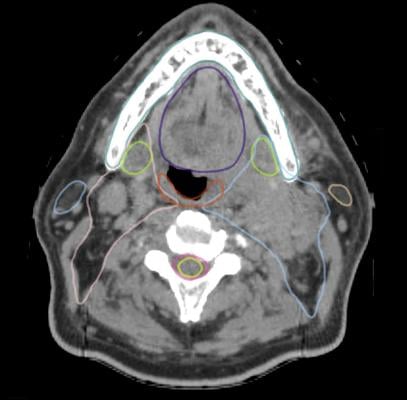
Unedited head-and-neck image generated by the RefleXion X1 displays excellent contrast and detail resolution, and near-perfect Limbus AI contours visible on several structures. (Photo: Business Wire)
March 28, 2024 — RefleXion Medical, Inc., a therapeutic oncology company, and Limbus AI, Inc., a provider of software solutions for cancer radiation therapy, today announced a licensing agreement to incorporate Limbus’ automated contouring software, Limbus Contour, into the RefleXion X1 radiotherapy treatment planning system. This integration will reduce the most significant bottleneck in the patient treatment planning process, which involves delineating the tumor target from surrounding critical organs and other healthy tissue.
“Contouring is one of the most time-consuming tasks in radiotherapy planning, and often contributes to treatment delays,” said Sam Mazin, Ph.D., co-founder and chief technology officer at RefleXion. “We have found Limbus Contour’s AI-driven solution to be a technology leader in speed, accuracy and versatility. Depending on the complexity of the treatment plan, we expect contouring time reductions of up to 80%1, thus ensuring that patients receive timely treatment.
“Furthermore, this sets the stage for adapting the treatment plan immediately prior to delivery to leverage the unique and rich anatomic and biologic information produced by the X1 in image-guided and SCINTIX procedures,” continued Mazin.
Radiotherapy treatment planning begins with the patient undergoing computed tomography (CT) imaging of the tumor target. Clinicians then manually outline or “contour” both the treatment area and the nearby organs (known as organs at risk or OARs) where irradiation should be minimized. This manual process is time-consuming and often suffers from variability between clinicians, which can lead to inconsistencies in the quality of the treatment plan and limit its effectiveness. Limbus Contour employs clinically validated, deep-learning segmentation algorithms with a high level of accuracy to reduce human error and help ensure precise radiation delivery to target areas and avoidance of OARs.
“The performance of Limbus Contour software relies on the quality of the CT image,” said Karl Otto, Ph.D., CEO at Limbus AI. “X1 images demonstrate high resolution, exceptional contrast, and minimal noise and motion artifacts. This should enhance precision in distinguishing adjacent structures and yield consistent, reliable contouring results, ensuring patients receive the highest quality care possible.”
The X1 with SCINTIX technology is a dual-treatment modality radiotherapy platform that can treat patients with FDA-cleared indicated solid tumors of any stage. Both treatment modalities, biologic and anatomic, will benefit from the efficiencies of Limbus Contour integration.
For more information: https://reflexion.com/
Reference:
1Hoque SMH, Pirrone G, Matrone F, Donofrio A, Fanetti G, Caroli A, Rista RS, Bortolus R, Avanzo M, Drigo A, et al. Clinical Use of a Commercial Artificial Intelligence-Based Software for Autocontouring in Radiation Therapy: Geometric Performance and Dosimetric Impact. Cancers. 2023; 15(24):5735. https://doi.org/10.3390/cancers15245735


 April 25, 2024
April 25, 2024 








